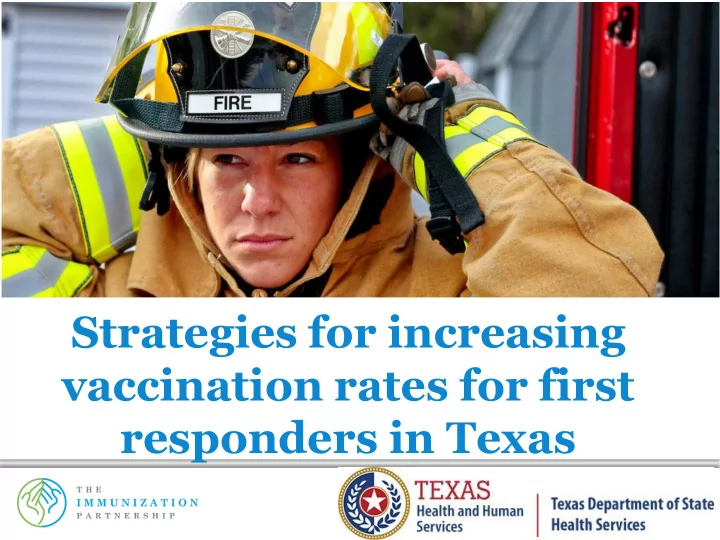

Strategies for increasing vaccination rates for first responders in Texas www.immunizeUSA.org
Learning Objectives 1. Review adult vaccination coverage in Texas. 2. Discuss the changing environment for adult immunization. 3. Describe recommended strategies for improving vaccine coverage in first responders. www.immunizeUSA.org
The Texas Department of State Health Services Immunization Unit is pleased to work with The Immunization Partnership to present these webinars to immunization coalitions and immunization partners throughout Texas. These webinars, along with resources available through www.immunizeusa.org, work to ensure information and guidance are available to providers and the public. www.immunizeUSA.org
The Immunization Partnership • Vision » A community protected from vaccine-preventable diseases. • Mission » To eradicate vaccine- preventable diseases by educating the community, advocating for evidence-based public policy and promoting immunization best practices. www.immunizeUSA.org
Adult Vaccination Rates
Percentage of healthcare personnel who reported receiving influenza vaccination by occupation type, United States, 2010 – 11 through 2015 – 16 influenza seasons Source: Centers for Disease Control and Prevention
What is a First Responder? • Individuals who protects life, evidence, property or the environment during the early stages of an emergency. • Examples of first responders: – Fire fighters, – Law enforcement personnel, – Emergency medical personnel, – Utility workers, and – Public health professionals. www.immunizeUSA.org
RECOMMENDED VACCINES FOR FIRST RESPONDERS www.immunizeUSA.org
Tetanus • Give 1 dose every 10 years • Four kinds of vaccines used today protect against tetanus – Diphtheria and tetanus (DT) vaccines – Diphtheria, tetanus, and pertussis (DTaP) vaccines – Tetanus and diphtheria (Td) vaccines – Tetanus, diphtheria, and pertussis (Tdap) vaccines www.immunizeUSA.org
Hepatitis B • 3 dose series – 0,1,6 months • Obtain anti-HBs serologic testing 1-2 months after third dose to establish immunity. www.immunizeUSA.org
Hepatitis A • 2 dose series • Obtain serologic testing 1-2 months after second dose to establish immunity. www.immunizeUSA.org
Meningococcal • Give both MenACWY and MenB • Booster recommended every 5 years www.immunizeUSA.org
MMR 2 doses of MMR vaccine are recommended during an • outbreak of measles or mumps and 1 dose during an outbreak of rubella in individuals with no evidence of immunity • Birth before 1957 is considered acceptable evidence of measles, mumps, and rubella immunity – 2 doses of MMR vaccine should be considered for unvaccinated HCP born before 1957 who do not have laboratory evidence of disease or immunity to measles and/or mumps – One dose of MMR vaccine should be considered for HCP with no laboratory evidence of disease or immunity to rubella • Born in 1957 or later can be considered immune to measles, mumps, or rubella only if they have – Laboratory confirmation of disease or immunity, or – Appropriate vaccination against measles, mumps, and rubella www.immunizeUSA.org
Varicella • 2 doses of varicella vaccine given at least 28 days apart • Not needed if: – Medical history confirms a varicella of zoster diagnosis – Laboratory evidence of immunity www.immunizeUSA.org
Influenza • Give 1 dose annually www.immunizeUSA.org
NVAC STANDARDS FOR PROFESSIONAL HEALTH-CARE- RELATED ORGANIZATIONS, ASSOCIATIONS, AND HEALTH-CARE SYSTEMS www.immunizeUSA.org
Standards with respect to immunizations include: • Develop policies and/or regulations that promote high vaccination rates and reduce immunization barriers for adult patients and their providers. • Emphasize the importance of immunizations during all patient encounters, incorporate patient assessment of vaccine needs into routine clinical practice, and document vaccination status in patient medical records. • IISs and EHRs should be referenced as sources of data about a patient's vaccine history. • Strongly recommend all immunizations that are needed.
Immunization Information Systems • Texas uses a statewide In 2015, only immunization registry 3% of adults in Texas • More should be done enrolled in the to encourage adult statewide participation registry at all, and only 2 percent had at least 1 vaccine dose in the registry
Standards with respect to immunizations include: • Provide educational information on immunizations into professional trainings. • Provide resources and assistance for providers to implement protocols or standing orders.
Standing Orders • Gives non-physician healthcare personnel (ex. physician assistants, nurses and medical assistants) directive to administer vaccines without a prescription to eligible patients
Reminder/Recall • Identify and contact patients who have upcoming vaccine doses (reminder) or have missed doses (recall)
Standards with respect to immunizations include: • Encourage first responders to ensure that their own vaccinations are up-to-date as a standard of the profession. • Make educational materials regarding immunizations available in the work place.
Standards with respect to immunizations include: • Participate in collaboration opportunities with other members of the immunization community. • Insurers/payers/entities that cover adult immunization services should ensure that their networks are adequate to provide timely immunization access and augment with additional vaccine providers, if necessary. • Examples: – Public health, – Public and private medical, – Nursing, – Pharmacists, – Patient advocacy, and – Health systems.
Standards with respect to immunizations include: • Ensure preparedness for outbreaks of vaccine- preventable diseases when they occur. • Managing these outbreaks should include activities such as: – creating, – maintaining, and – practicing emergency preparedness plans for vaccine responses to outbreaks such as pandemic influenza. • Promote adherence to applicable laws, regulations, and standards among adult immunization stakeholders.
Questions? Please feel free to contact: Katy Gore, MPH Coalitions and Education Program Manager kgore@immunizeUSA.org (281) 769-3087 www.immunizeUSA.org
Thank you for all you do! Thank you! www.immunizeUSA.org
Recommend
More recommend